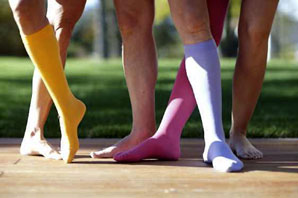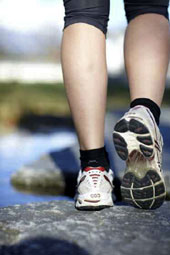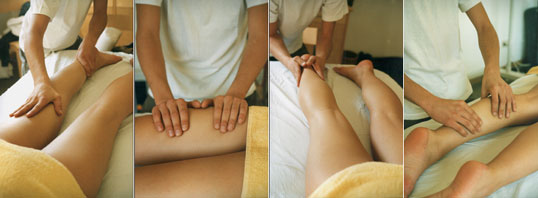The most common misconceptions and myths about varicose veins
"I have repeatedly found that many people pick up some theories, parrot them unchecked and put themselves in the unfortunate situation of remaining in this misconception for years, if not decades, and basing all their actions on this misconception. If such an error becomes popular opinion, I speak of a myth, if one's own theories and actions are linked to it, I speak of a creed" (from the book "Was gesunde Beine brauchen", Ueberreuter Verlag, © 2010)
Few diseases are subject to such persistent misconceptions, myths and beliefs as venous disorders and varicose veins. For decades, rumors have "kept themselves alive", blocking the way to solving the problem for those affected.
Venesthetic® is a forum for critical thinkers and patients who are looking for a quick route to their goal - a flawless leg. Only the clearing out of false beliefs creates the freedom for recovery. The book "What healthy legs need" should be a foray into a new world of thought and help the reader to understand complex relationships between biology and physics in an almost playful way.
Why isn 't crossing your legs unhealthy? The individual topics provide a brief insight ...
The most common misconceptions and myths about varicose veins
Whether sitting in yoga in Asia, cross-legged in South America, squatting on the floor in Africa, with arms folded or fingers interlaced - these people can be found all over the world and not just on talk shows or in soccer stadiums.
We humans cross our legs to take the strain off them, to sit more comfortably, to relax. The anatomy of the human body is designed in such a way that the blood can flow back to the heart more easily.
If crossing the legs caused venous disease, people in those parts of the world where they are crossed much more would have more venous disease than in Europe.
They are all associated with varicose veins. Nevertheless, many people with varicose veins regularly visit the sauna, you can find people with varicose veins lying on the beach or on safari in the hottest regions of the world, and people with varicose veins lie in the thermal bath or bathtub without any complaints.
In the south, where the floors are all at a pleasant temperature, we feel comfortable, enjoy the warmth and are free of aches and pains. The children play happily on the warm living room floor and we enjoy the cozy temperature of the tiles in the bathroom barefoot.
Varicose veins are caused by gravity, varicose veins are caused by a lifetime of sitting in chairs, varicose veins are caused by a lack of exercise. If varicose vein sufferers stand for hours in the heat, they get swollen legs and discomfort - because they have been standing for hours.
Heat promotes vasodilation and blood circulation, heat strengthens health.
If the theory of veins and heat were true, people living in latitudes close to the equator would suffer much more from varicose veins.
 Many people today are caught in an emotional conflict between wanting to enjoy the sun and being afraid of its harmful rays. Sun is vital, just as sun protection protects against illness.
Many people today are caught in an emotional conflict between wanting to enjoy the sun and being afraid of its harmful rays. Sun is vital, just as sun protection protects against illness.
The sun's UV radiation converts a cholesterol derivative in the skin into vital vitamin D3, of which the European population is severely deficient according to numerous recent scientific studies.
Sun does not damage the veins in any way, as many people believe, nor has the development of spider veins been scientifically confirmed. After varicose vein surgery and spider vein sclerotherapy, the same laws apply as after any other injury to the skin.
In our practice, no unusual side effects of any kind have been observed as a result of sun exposure in patients undergoing treatment.
If the thesis of veins and sun were correct, people living in latitudes close to the equator would suffer more from skin changes.
If underfloor heating had a pathogenic effect on the veins, people in latitudes close to the equator would have to have many more venous diseases than in Central Europe.
Why do so many people ask when traveling by plane
whether they should have a blood thinner injection with them? Why don't they ask for it when they are traveling by private car, coach or train?
The fear of traveler's thrombosis
is relatively unfounded. The fear of a  The risk of thrombosis when traveling by air is not significantly higher than when traveling by bus, train or car. It is also not justified if you have never suffered from any significant venous disease. Spider veins and Varicose veins are no reason to worry about getting a travel thrombosis, even patients with varicose veins as thick as a thumb get off airplanes in their thousands without deep vein thrombosis. However, people with advanced varicose veins often have more symptoms such as a feeling of heaviness and swelling. For this reason, wearing a compression stocking is recommended on long-haul flights, and many passengers are grateful to be able to walk the last few arduous meters through the terminal to the next bed on the other end.
The risk of thrombosis when traveling by air is not significantly higher than when traveling by bus, train or car. It is also not justified if you have never suffered from any significant venous disease. Spider veins and Varicose veins are no reason to worry about getting a travel thrombosis, even patients with varicose veins as thick as a thumb get off airplanes in their thousands without deep vein thrombosis. However, people with advanced varicose veins often have more symptoms such as a feeling of heaviness and swelling. For this reason, wearing a compression stocking is recommended on long-haul flights, and many passengers are grateful to be able to walk the last few arduous meters through the terminal to the next bed on the other end.
The blood thinning injection against travel thrombosis
is only indicated for people who have already suffered at least one thrombosis, who have a demonstrably increased risk, who have been examined by a vein expert (phlebologist), angiologist, vascular surgeon or coagulation specialist and who have been recommended to do so by him/her. In this case, however, they also need thrombosis prophylaxis for longer journeys (more than 4 - 6 hours) in other vehicles.
All travelers are recommended for longer trips
drink enough, take a few minutes of exercise in between by walking or doing gymnastics, wear compression stockings up to the knee and, if possible, elevate your legs - but this applies to all forms of transportation! Flights in First or Business Class allow much more legroom and therefore pose no significant risk at all.
To explain this in more detail: In passenger aircraft, the cabin pressure at +/-10,000 meters cruising altitude corresponds to an altitude of approx. 2,000 meters above sea level. Outside, however, the atmospheric pressure is only 0.5 atm, which means that the humidity of the compressed breathing air in the pressurized cabin is only about 15% - the only difference to trains, buses or cars - but easily sufficient for trouble-free transport with a sufficient supply of liquids.
 They used to be thick, warm, ugly brown, difficult to put on ... - they were seen as a constraint.
They used to be thick, warm, ugly brown, difficult to put on ... - they were seen as a constraint.
Today they are fashionable.
Compression clothing is becoming a trend. Gentle compression of the legs makes you fit, increases alertness, keeps you vital and makes you feel good.
The modern medical compression stocking is also comfortable to wear today and serves to improve the well-being of patients with diseases of the venous system. Thanks to the simplified treatment methods in Venesthetic® wearing compression stockings is no longer an obligation, in many cases one day or even a week is enough to be fit again and completely free of symptoms - people like wearing them!
Compression socks and compression garments were introduced to competitive sports a few years ago: Long-distance athletes (marathon, triathlon, swimming) wear compression garments because - as sports science has proven - performance increases. Read about the trends of tomorrow here >>
Did you know that the compression pressure of a class II medical compression stocking on the skin corresponds to that of water at a depth of 30-40 cm?

For decades, medicine had to put up with the accusation that the treatment of varicose veins was not very successful and that new ones would soon appear again.
Today, new treatment methods and consistent follow-up treatment after operations and sclerotherapy make it possible to achieve a flawless leg. Only a leg that is completely free of residual varicose veins can prevent further varicose vein growth. Early presentation and intervention also prevents varicosis, which can take a long time to treat.
In the past, patients were often put off by doctors for years and treatment was postponed, causing the vein problems to increase. Young women were first told to "give birth to all their children" and after the last pregnancy they were heartbroken about their legs. At that time, surgery had no gentle technique for removing varicose veins from the legs without leaving scars or residue.
Good and lasting results can only be achieved with perseverance. Venesthetic® vein prophylaxis is the prerequisite for beautiful and healthy legs. Young and old alike can optimize their quality of life and prevent open legs.
Varicose veins will keep coming as long as they are not gone!
People with vein disease suffer from a feeling of heaviness, tiredness and swelling of the legs. Leg elevation, gymnastics, walking, running and massage are welcome ways to relieve the strain after long periods of standing and sitting.
In many cases, varicose veins are not treated for years, as a result of which these complaints constantly increase. Operations and subsequent sclerotherapy, perhaps often sclerotherapy alone, relieve the feeling of heaviness and swelling. Lymphatic drainage is particularly recommended not only after such treatments, but also when the legs are exhausted. In principle, most forms of massage are perceived as pleasant and healing.
Massages have repeatedly been postulated as contraindicated in connection with varicose veins, but the most severe forms of varicose veins with the risk of embolization of thrombi are very rare today and should generally be treated with surgery as soon as possible.
The legs carry the human body, they are most exposed to the force of gravity, with the soles of the feet bearing 60, 70, 80 or more kilos. Bones, joints, ligaments and muscles have to withstand this strain - as does the venous system.
Beautiful legs are healthy legs.
Healthy legs are beautiful legs.
The future will make us think differently.
People will no longer watch the growth of varicose veins uncritically, because: the earlier, the easier and more beautiful they are to remove.




